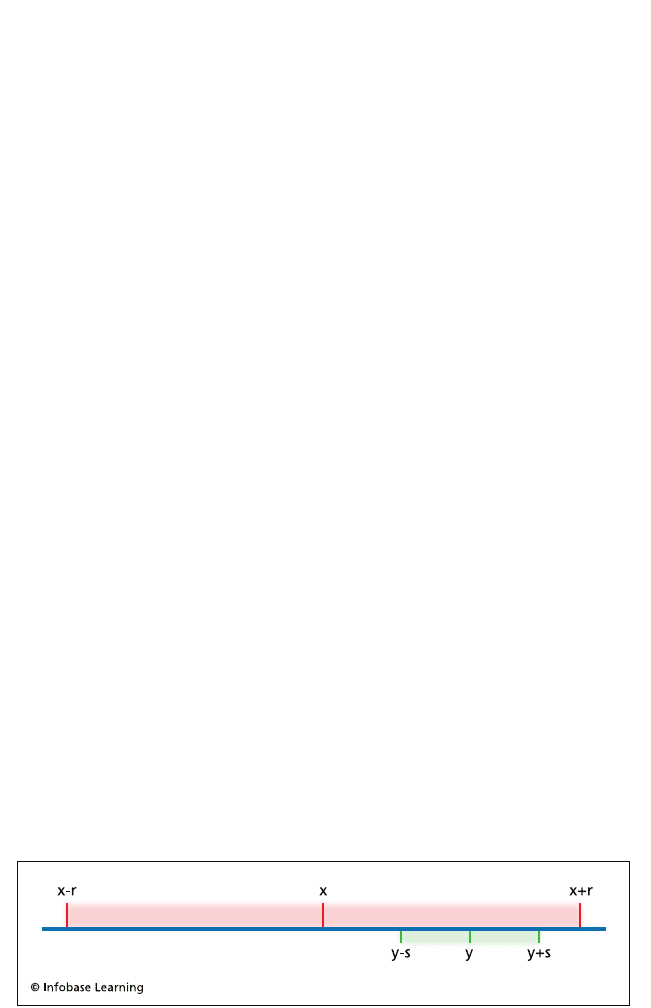Tabak J. Beyond Geometry: A New Mathematics of Space and Form
Подождите немного. Документ загружается.


50 BEYOND GEOMETRY
of I. Just as Weierstrass required that his infinite point set in the
plane be bounded, Ascoli also required that his set S be bounded.
In Ascoli’s case, that means that there is a single positive number
M such that − M ≤ f(x) ≤ M for every element f in S. (This condi-
tion describes a “circle” centered at the “point” h(x) defined by the
condition h(x) = 0 for all x in the interval a ≤ x ≤ b.) Again, the idea
is exactly the same as in the Bolzano-Weierstrass theorem.
Ascoli showed that whenever the infinite set S is bounded, the
space I contains a function that is a limit point of S. In other
words, there is a function g belonging to I—and g may or may not
belong to S—such that every circle centered at g will also contain
elements of S different from g. (In fact, it will contain infinitely
many elements of S.)
To summarize: The set I corresponds to the plane. Ascoli’s
bounded set S corresponds to the bounded set S in the Bolzano-
Weierstrass theorem, and the functions belonging to I—or, more
properly, the points of I—correspond to the points in the plane.
Ascoli generalized the notion of point, which had previously been
a geometric concept, to include functions. Ascoli’s “space” is a
space of functions. He showed that two very different-looking
spaces of points share an important property: In both spaces,
infinite bounded sets have limit points. Ascoli’s discovery raised
the question of what other properties might be shared by very
different-looking spaces of points, and this is exactly the kind of
question that topology enables one to answer.
Different-Looking Sets, Similar Properties: Part II
Another interesting generalization of the idea of “point” was
proposed by the French mathematician Émile Borel (1871–1956).
Borel was an extremely productive mathematician and a staunch
French nationalist. Drawn to mathematics at an early age, he
began to publish mathematical papers while still an undergradu-
ate. He received a Ph.D. at the age of 22, and for years there-
after, he averaged a mathematical paper every few months. He
also wrote several books. During World War I, he volunteered
to fight for France as an officer in an artillery battery. After the

A New Mathematical Landscape 51
war, he continued his research into mathematics and also served
in the French government—first in the national legislature, the
Chamber of Deputies, and in the late 1930s, as minister of the
Navy. He was imprisoned after the German conquest of France
and later joined the French Resistance. Mathematically, Borel is
best remembered for his contributions to the theory of probabil-
ity, set theory, and measure theory. His name is also attached to
an important topological result, which is described in chapter 5.
In this chapter, we recall two of Borel’s contributions. The first
contribution of interest is not widely remembered today, but it was
an interesting generalization of the notion of point. This paper,
which was published in 1903, considered a set the elements of which
were lines in the plane. In other words, whereas Cantor had inves-
tigated sets of geometric points, Borel investigated sets in which
lines took the place of geometric points. He defined a method for
computing the distance between any two lines in the set. A function
that is used to compute the distance between pairs of points in a
set is called a metric. Borel used his metric to define the concept of
“closeness” as it applied to his “space” of lines. With the help of his
metric, Borel could investigate questions about the structure of his
set. He could answer questions such as the following:
• Given a set S of lines and a line l belonging to S, is l an
interior point of S?
• Given a set S of lines and an arbitrarily chosen line l, is
l a limit point of S?
• Given a set S of lines, is S open? Closed? Neither?
(Unlike doors, in topology the words closed and open
are not antonyms. As demonstrated in chapter 5, a set
can, for example, be open and closed simultaneously.)
Borel’s paper is a nice illustration of some of the ways that
mathematicians of the time were generalizing the set theoretic
discoveries of Cantor. In his 1903 paper, Borel also included a con-
ceptually similar analysis of a set of planes in three-dimensional
space. In this space, planes played the role of points. Again, he

52 BEYOND GEOMETRY
defined a metric on the set of planes and asked and answered a
number of interesting questions about limit points, interior points,
and so forth. On the one hand, it may be difficult to see immediate
practical applications for Borel’s ruminations about the properties
of sets of lines in the plane and sets of planes in three-dimensional
space, but his paper helped mathematicians further generalize the
concept of point. This was an important consideration at the time,
and a highly abstract conception of the term point is now at the
center of mathematical thought.
The other contribution Borel made to the development of
topology that is of interest to us concerns his very important gen-
eralization of the concepts of open set and closed set. Recall that an
open set is defined as a set with the property that every element
in the set is an interior point of the set. Sets, whether or not they
are open, may be combined by taking their union. (The union of
the two sets A and B is the set consisting of all the elements of A
and all the elements of B. The union of A and B is written as A ∪
B.) As a matter of definition, if P is an interior point of the open
set A, it will be an interior point of any set to which A belongs.
In other words, if P lies in the interior of A, it will also lie in the
interior of any set that contains A. As a consequence, the union of
any collection of open sets must be an open set.
Consider, for example, the collection of open sets {x: 0 < x < 1},
{x: −1 < x < 0}, {x: 1 < x < 2}, {x: −2 < x < −1}, . . . Each set in the
collection consists of all the real numbers between two adjacent
integers, and each set is an open set. Consequently, the union of all
such sets is open. (Another logical consequence of this example is
that the set of integers, which is the set of all numbers not belong-
ing to the union, is a closed subset of the set of all real numbers.
Why? As a matter of definition—see page 46—the set of all ele-
ments not belonging to an open set is a closed set.)
The intersection of any finite collection of open sets is an open
set, but the intersection of an infinite collection of open sets may
or may not be an open set. (The intersection of a collection of
sets consists of exactly those points that belong to all of the sets
in the collection.) Consider, for example, the collection of open
sets {x:
−
1
⁄
n
< x <
+
1
⁄
n
}, where n can represent any natural number.
First, notice that each such set is open, but the intersection of all

A New Mathematical Landscape 53
these sets is {0}, and the set consisting of the single number zero is
a closed set. (To see why this is true, choose any number x differ-
ent from zero. Draw a circle with x as its center and with a radius
so small that the number zero lies outside the circle. This dem-
onstrates that the set of all nonzero numbers is open because each
element in the set is an interior point of the set. Consequently, the
set consisting of the number zero is closed.)
Borel defined a new class of sets called “G-delta” sets, which are
represented by the symbol G
δ
. A G
δ
set is a generalization of the
concept of an open set. A G
δ
set is any set that can be represented
as the intersection of a countable intersection of open sets. This
includes all open sets and many sets that are not open.
In a similar way, Borel generalized the concept of closed set.
Because the union of any collection of open sets is open, it follows
that the intersection of any collection of closed sets is closed. To
see why, let A and B be open subsets of the real line. Let ~A rep-
resent the set of all points on the real line that do not belong to A.
The set ~A is closed because A is open. (The expression ~A is pro-
nounced “the complement of A.”) Let ~B represent the complement
of B. Again, because B is open, ~B is closed. Finally, let ~ (A ∪ B)
represent the complement of the union of A and B. A famous set
theoretic “law” that many students encounter in their high school
math classes—one of the so-called de Morgan’s laws—states that
the complement of the union of two sets equals the intersection of
the complements. In symbols, this is written in the following way:
(~ A) ∩ (~ B) = ~ (A ∪ B)
Because A and B are open, so is A ∪ B, and because A ∪ B, is
open, its complement is closed. Therefore, the intersection of
the two closed sets ~A and ~B is closed. This is an example of the
“set-theoretic calculus.” (A very sophisticated version of the set-
theoretic calculus was developed early in the 20th century by the
Polish topologist Kazimierz Kuratowski.)
Just as the countable intersections of open sets may or may not
be open, the countable union of closed sets may or may not be
closed. Borel defined another category of sets, a generalization of
the concept of closed set, called an “F-sigma” set, and it is denoted

54 BEYOND GEOMETRY
with the symbol F
σ
. (The symbol σ is the Greek letter sigma.)
Every F
σ
can be written as the countable union of closed sets.
The collection of open sets, closed sets, G
δ
sets, and F
σ
sets (as
well as generalizations of the G
δ
and F
σ
sets) form the collection of
what are now known as Borel sets. Borel sets are used extensively
in probability theory, topology, and analysis.
This was the situation in the early years of the 20th century:
Mathematicians were now faced with a dizzying array of sets.
There were, for example, sets of geometric points, sets of func-
tions, sets of lines, and sets of planes, and on each of these sets they
imposed structure in the form of open sets and closed sets, metrics,
limit points, G
δ
sets, and F
σ
sets. They discovered many interesting
relations among these sets. Their research revealed properties that
some sets of points have but that other sets of points do not have.
They gave names to these newly discovered properties, and they
investigated the logical implications of their discoveries.
At a very basic level, early topologists were seeking criteria that
would enable them to determine when two different-looking sets
are fundamentally the same and when they are different. This is
just what Euclid had done more than 2 millennia earlier. Euclid’s
answer to the problem of applying the concept of “sameness” to a
collection of figures was what we now know as the set of Euclidean
transformations. If, using any series of Euclidean transformations,
one object can be made to coincide with another, then they are
the same; otherwise, they are different. Topologists sought a con-
ceptually similar criterion for determining when sets are the same,
but because the sets imagined by 19th- and early 20th-century
mathematicians were often so different looking—sets of geometric
points versus sets of lines in the plane versus sets of functions, for
example—they needed to identify a set of transformations that
were quite different from those of Euclid. These are now called
topological transformations. These mathematicians also sought to
identify exactly those properties that are preserved under the set
of topological transformations, and, out of this effort, they created
the discipline of set-theoretic topology.

55
4
the first
topological spaces
Mathematical knowledge agglomerates. When progress is made,
mathematical discoveries are published for all to see, and the new is
added to the old. In mathematics, new knowledge does not replace
old knowledge, it grows alongside it. This is different from the way
science often progresses. In science, new discoveries often replace
old ones. The Renaissance-era discovery that the Earth orbits the
Sun replaced the more ancient belief that the Sun orbits the Earth.
The ancient Earth-centered model was abandoned because it was
incorrect. By contrast, mathematical knowledge is never aban-
doned. No mathematical discovery can show Euclidean geometry
is incorrect, because Euclidean geometry is logical, and the sole
criterion for truth in mathematics is logic. A statement that is a log-
ical consequence of a set of axioms remains a logical consequence
for all time. As new mathematical discoveries are added to the old,
they create a more diverse store of mathematical knowledge.
By 1910, the store of mathematical knowledge had become very
diverse, indeed. In particular, Cantor’s theory of sets had become
an important and independent branch of mathematics, but its
importance extended far beyond questions about the nature of
sets of geometric points. Researchers in many different fields
began to express their insights using the ideas and vocabulary
created by Cantor—cardinality, one-to-one correspondences,
open sets, closed sets, interior points, limit points. His insights
had provided a basis for a new and unifying conception of math-
ematics. Sets were not just passive collections of objects; they
had structure, and researchers began to use those structures to

56 BEYOND GEOMETRY
compare and contrast sets. They wanted to understand the rela-
tionships that exist among very different-looking sets of points,
and with their more abstract conception of the word point, almost
everything could be described as a set of points. They wanted
to know when different-looking sets were fundamentally the
same and when they were fundamentally different. Faced with
diversity, they sought unity. As they attempted to understand sets
at their most basic level, they created the field of set-theoretic
topology as it is understood today.
Felix Hausdorff and the First Abstract
Topological Spaces
The German mathematician Felix Hausdorff (1868–1942) was
a pioneer in the attempt to create useful abstract topological
spaces. He was born in Breslau in the former state of Prussia—
now Wrocław, Poland—and grew up in Leipzig, Germany. He
studied mathematics and astronomy at the University of Leipzig,
and his Ph.D. thesis was about a topic in astronomy. In addition
to his work in topology, he also wrote a number of literary works.
Under the pseudonym Dr. Paul Mongré, Hausdorff wrote poetry,
philosophy, and even a play. Philosophically, he was an admirer of
the German philosopher and critic Friedrich Nietzsche, and in his
writings about philosophy, Hausdorff speculated extensively about
the nature of time. His play was a comedy about two men and their
plans to fight a duel, and it was a success. At a theater in Berlin, the
play had a run of more than 100 performances. Historically speak-
ing, not many mathematicians have written successful comedies.
Today, Hausdorff is remembered primarily for his work in topol-
ogy and for the tragic way his life ended. Despite international rec-
ognition for the quality of his work in topology, Hausdorff, who was
Jewish, lost his job in 1935 as a result of the policies of the National
Socialist Party (Nazis). Unlike many of his Jewish contemporaries
in academia, Hausdorff, who certainly could have left Germany,
remained at home. When no German journal would publish his
papers, he published them in Fundamenta Mathematicae, a Polish
mathematical journal that emphasized topological research. In 1942,

The First Topological Spaces 57
when the authorities ordered
Hausdorff, his wife, Charlotte
Hausdorff, and his sister-in-
law, Edith Pappenheim, to
move to a concentration camp,
the three of them committed
suicide. They are buried in
Bonn, Germany.
In topology, Hausdorff’s most
influential work, which is almost
always identified by its German
name, is entitled Grundzüge
der Mengenlehre (Basics of Set
Theory). Hausdorff published
his treatise in 1914, and it con-
tains the first detailed axiom-
atic investigation of abstract
topological spaces. It begins by
defining a topological space as
a set X of “points” together
with a collection of subsets of X
called neighborhoods. (Today, the
term neighborhood is often used
synonymously with the term open set.) In Hausdorff’s model, the col-
lection of neighborhoods satisfies the following four axioms:
Axiom 1. For each x in X, there is at least one neighborhood,
which we will call U, containing x.
Axiom 2. Let U and V be two neighborhoods of the point x.
The intersection of U and V contains a neighborhood of x. (The
intersection of the two neighborhoods, which is written symbol-
ically as U ∩ V, is the set of points belonging to both U and V.)
Axiom 3. Suppose that U, which is a neighborhood of x, also
contains the point y, then the neighborhood U also contains a
neighborhood of y.
Felix Hausdorff was one of the first
to create “abstract” topological spaces.
His work permanently changed the
history of the subject.
(University of
Bonn)

58 BEYOND GEOMETRY
Axiom 4. If x and y are distinct points in X, then there exist
neighborhoods U of x and V of y such that the two neighbor-
hoods share no common points. In symbols, this idea can be
expressed in the following way: U ∩ V = ∅ for some choice of
neighborhoods U and V.
Hausdorff’s conception of a topological space is not quite the
same as the one currently in use, but his axiomatic develop-
ment of the subject is conceptually similar to the way topology is
expressed today. It is also conceptually similar to the way Euclid
developed geometry in Elements. To better understand topology
and its history, it is worthwhile to develop an appreciation for
what Hausdorff’s axioms actually imply. Later in the volume, we
will compare his axioms to the ones in general use today. First,
consider each of the following examples:
Example 4.1: Let X represent the real line. To make X a topo-
logical space (as Hausdorff understood it) we need to identify
the neighborhoods. This is easier if we introduce some nota-
tion. Let U(x, r) stand for the set of real numbers within r
units of the point x. The letter x represents an arbitrary real
number, and the letter r represents an arbitrary positive real
number. In symbols, we can write U(x, r) = {t: x − r < t < x + r}.
Or to put it still another way, if we draw a small circle about x
of radius r, U(x, r) contains all the points on the real line that
lie within this circle. Every positive number r gives us another
neighborhood of x. Now let us check that the set X together
with the set of all such neighborhoods U(x, r) satisfy each of
Hausdorff’s axioms:
1. Every point x of the real line belongs to some—in fact,
infinitely many—neighborhoods of the form U(x, r), so
Hausdorff’s first axiom is satisfied.
2. To see that Hausdorff’s second axiom is satisfied, let U(x, r)
and U(x, s) be two neighborhoods of the point x. Their inter-
section will also contain a neighborhood of x. (Because both
intervals are centered at x, the smaller of the two intervals
will satisfy the requirement.)

The First Topological Spaces 59
3. Consider the neighborhood U(x, r), and let y be a point
belonging to this neighborhood, then there is a neighbor-
hood of y that also lies in x. To see this, suppose that y lies to
the right of x so that x < y < x + r. Let s be a positive number
so small that y + s < x + r, then the neighborhood U(y, s) lies
within U(x, r). (If y lies to the left of x, then choose s to be so
small that x − r < y − s. For this value of s, U(y, s) will belong
to U(x, r).) See the accompanying illustration.
4. If x and y are any two distinct real numbers, we can always
draw two small circles, one centered at x and one centered at
y, that do not overlap. Choose one neighborhood of x that
lies entirely within the circle about x, and choose one neigh-
borhood of y that lies entirely within the circle about y. These
neighborhoods satisfy Hausdorff’s fourth axiom.
Example 4.2: Let X be the interval {x: 0 < x < 1}. Use the same
neighborhoods that were defined in Example 4.1, but discard
any neighborhood from Example 4.1 that extends beyond the
endpoints of {x: 0 < x < 1}. Hausdorff’s axioms are satisfied, and
the proof is identical to that found in Example 4.1.
Example 4.3: Let X be the union of these two intervals:
{x: 0 < x < 1} and {x: 2 < x < 3}. Use the same neighborhoods that
were defined in Example 4.1, but discard any neighborhoods
from Example 4.1 that contain points outside the two intervals.
Hausdorff’s axioms are satisfied, and the proof is identical to that
found in Example 4.1.
The set of all real numbers together with the collection of subsets of the
form {t: x − r < t < x + r} for every positive real number x satisfies
Hausdorff’s axioms. This picture illustrates that axiom 3 is satisfied.
